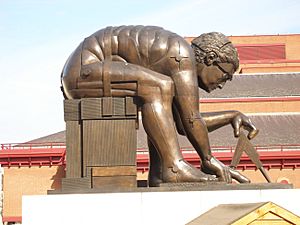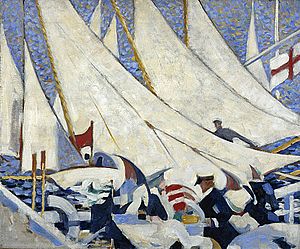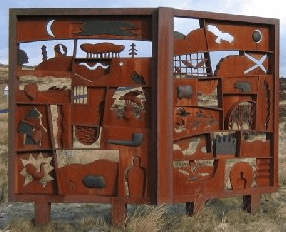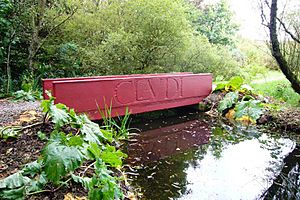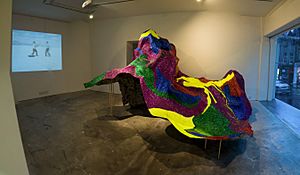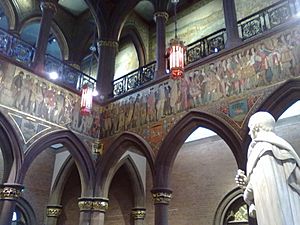Art in modern Scotland facts for kids
Art in modern Scotland is all about the amazing paintings, sculptures, and other visual artworks created in Scotland since the early 1900s.
At the start of the 20th century, a group called the Glasgow School was very famous. They were known for mixing old Scottish styles with new art movements like Art Nouveau. Later, artists known as the Scottish Colourists brought bright, bold colours to Scottish art. Then came the Edinburgh School, who also loved strong colours.
Many artists started exploring Modernism, which was a new way of thinking about art. A movement called the Scottish Renaissance encouraged Scottish artists to create unique national art. After World War II, artists like John Bellany and Alexander Moffat focused on "Scottish realism," showing everyday life. Later, a group known as the "new Glasgow Boys" continued this idea. Today, Scotland still has many influential artists, including Douglas Gordon and Susan Philipsz.
Scotland has many fantastic places to see art, like the National Gallery of Scotland in Edinburgh and the Burrell Collection in Glasgow. Important art schools include the Edinburgh College of Art and the Glasgow School of Art. Creative Scotland is the main group that helps fund and support the arts in the country.
Early 20th Century Art
The Glasgow School
In the late 1800s and early 1900s, a group of artists in Glasgow became very well known. The most important part of this group was "The Four," also called the "Spook School." This group included the famous architect Charles Rennie Mackintosh (1868–1928), his wife and artist Margaret MacDonald (1865–1933), her sister Frances (1873–1921), and Frances's husband, Herbert MacNair (1868–1955).
They mixed different styles, like old Celtic Revival art, the Arts and Crafts Movement, and Japanese art. Their unique style became popular across Europe and helped define the Art Nouveau look.
The Scottish Colourists
The first big group of Scottish artists in the 20th century were the Scottish Colourists, who became famous in the 1920s. This name was given later to John Duncan Fergusson (1874–1961), Francis Cadell (1883–1937), Samuel Peploe (1871–1935), and Leslie Hunter (1877–1931).
They knew each other and showed their art together. All of them had spent time in France before 1914. They found inspiration in Paris, especially from artists like Monet, Matisse, and Cézanne, who were part of the Fauvist movement. The Colourists combined these French techniques with traditional Scottish painting. They are seen as the first Scottish modern artists and helped bring Post-Impressionism to Scotland. Fergusson, in particular, was very important in bringing modern art ideas to Scotland.
The Edinburgh School
A group of artists connected to Edinburgh became known as the Edinburgh School. Most of them studied at the Edinburgh College of Art around the time of the First World War. They were influenced by French painters and the St. Ives School in England.
Their art often used bright, strong colours that were not always natural. They focused on bold painting techniques rather than perfect shapes. Key members included William Gillies (1898–1973), who painted landscapes and still life. John Maxwell (1905–62) created imaginative scenes. William Crozier (1893–1930) made landscapes with glowing colours. William MacTaggart (1903–81) was known for his landscapes of Scotland, France, and Norway. Anne Redpath (1895–1965) was famous for her flat, two-dimensional paintings of everyday objects.
Modernism and the Scottish Renaissance
The idea of a "Scottish Renaissance" was first used by writer Patrick Geddes (1854–1932). He believed that new technology should go hand-in-hand with art. This idea was picked up by a new generation, led by the poet Hugh MacDiarmid. He argued for a mix of science and art, bringing modern art into Scotland, and creating a unique Scottish art style.
These ideas appeared in art between the two World Wars. Artists like Stanley Cursiter (1887–1976), William McCance (1894–1970), William Johnstone (1897–1981), and Fergusson were part of this. Stanley Cursiter was influenced by Celtic art, Post-Impressionism, and Futurism, which you can see in his paintings like Rain on Princes Street (1913). He later became director of the National Gallery of Scotland.
William McCance's early work was bold and Post-Impressionist. He later moved to London and his art became more abstract. William Johnstone also moved towards abstraction, trying to use parts of landscapes, poetry, and Celtic art in his work. His painting A Point in Time (1929–38) is considered one of the most important Scottish paintings of the century.
Other artists influenced by modernism included James McIntosh Patrick (1907–98) and Edward Baird (1904–49). They both trained in Glasgow and were influenced by Surrealism and the work of Bruegel. They often focused on landscapes, like McIntosh Patrick's Traquair House (1938).
New Scottish Group
Fergusson, one of the Scottish Colourists, returned to Scotland from France in 1939, just before World War II. He became a leader for a group of Glasgow artists. In 1940, members of Fergusson's group formed the New Art Club, which was different from the older Glasgow Art Club. In 1942, they held their first art show as the New Scottish Group, with Fergusson as their first president.
This group didn't have one single style, but they often shared similar political views. Their artists were influenced by art trends from Europe. Painters included Donald Bain (1904–79), who was influenced by Expressionism. William Crosbie (1915–99) was strongly influenced by Surrealism. Marie de Banzie (1918–90) and Isabel Babianska (b. 1920) were also influenced by Expressionism.
Millie Frood (1900–88) used bright colours and brushwork like Van Gogh. Her paintings of city scenes often showed social issues and realism. This was influenced by Polish refugees Josef Herman (1911–2000) and Jankel Adler (1895–1949), who lived in Scotland during the war. Tom MacDonald (1914–85) and Bet Low (1924–2007) formed the Clyde Group, which aimed to promote political art. Their work included industrial landscapes, like Low's Blochairn Steelworks (c. 1946).
Photography
In the early 20th century, important photography in Scotland included work by visiting artists like Alvin Langdon Coburn (1882–1966), who created pictures for books by Robert Louis Stevenson. Paul Strand (1890–1976) took atmospheric photos of the Hebrides. There were also famous photos of the Gorbals area in Glasgow by Bert Hardy (1913–95), Joseph MacKenzie (b. 1929), and Oscar Marzaroli (1933–88).
Later 20th Century to Today
Post-War Artists
After World War II, important artists included Robin Philipson (1916–92), who was influenced by the Colourists, but also by Pop Art. Robert MacBryde (1913–66), Robert Colquhoun (1914–64), and Joan Eardley (1921–63) all studied at the Glasgow School of Art. Eardley moved to Glasgow and painted the Scottish coast, as well as scenes of Glasgow buildings and children. Scottish artists like Wilhelmina Barns-Graham (1912–2004) and Margaret Mellis (1914–2009) continued landscape painting.
Paris remained a popular place for Scottish artists. William Gear (1916–97) and Stephen Gilbert (1910–2007) discovered the abstract painting of the COBRA group there in the 1940s. Their art was very colourful and energetic. Alan Davie (1920–2014) was influenced by jazz and Zen Buddhism, and moved into Abstract expressionism. Ian Hamilton Finlay's (1925–2006) work explored the connections between sculpture, printing, writing, and garden design. His most famous work is the garden of Little Sparta, which opened in 1960.
Scottish Realism and the Glasgow Pups
John Bellany (1942–2013), who focused on the fishing communities where he grew up, and Alexander Moffat (b. 1943), who painted portraits, were leading Scottish artists from the 1960s. Their style was called "Scottish Realism."
Artists who became famous in the 1980s, sometimes called the "new Glasgow Boys" or "Glasgow pups," were connected to Moffat and the Glasgow School of Art. They included Steven Campbell (1953–2007), Peter Howson (b. 1958), Ken Currie (b. 1960), and Adrian Wisniewski (b. 1958). Their figurative (meaning they painted people and objects) work often looked like comic books and focused on social issues. Campbell and Wisniewski used a playful approach to history in their post-modern paintings. Currie painted scenes about Glasgow's working-class history for the People's Palace in 1987.
Sculpture
The sculptures of Eric Schilsky (1898–1974) and Hew Lorimer (1907–93) followed traditional carving methods. However, sculptor Eduardo Paolozzi (1924–2005) was a pioneer of Pop Art. He created many works that explored the mix of fantasy and the modern world.
New government funding for the arts encouraged more experimental sculptors. These included artists like Jake Harvey (b. 1948) and Doug Cocker (b. 1945), who used modern art ideas. In contrast, Sandy Stoddart (b. 1959) creates traditional, realistic sculptures in clay, following the neoclassical style. He is famous for his public statues, like the 10-foot bronze figures of philosophers David Hume and Adam Smith in Edinburgh.
Photographic Renaissance
In the late 20th century, photography in Scotland became very popular again. This was helped by people like Richard Hough (1945–85), who started the Stills Gallery for photography in Edinburgh in 1977. Important photographers in Scotland included the American Thomas Joshua Cooper (b. 1946). More recent acclaimed photographers include Pradip Malde (b. 1957), Maud Sulter (1960–2008), and Owen Logan (b. 1963).
Contemporary Artists
Since the 1990s, one of the most successful artists has been Jack Vettriano (b. 1959). His paintings usually show people in different scenes. His most famous painting, The Singing Butler (1992), is often said to be the best-selling print in Britain.
Contemporary artists from Glasgow and Dundee include David Mach (b. 1960), who creates installation art (large artworks in a space). Richard Wright (b. 1960) is known for his detailed wall paintings. Jim Lambie (b. 1965) makes colourful sculptures, and Susan Philipsz (b. 1965) creates art using sound.
A group that came from the Glasgow School of Art in the early 1990s, sometimes called "The Irascibles," includes Roderick Buchanan (b. 1965), who works with installations, film, and photography. Douglas Gordon (b. 1966) is famous for his video art. Christine Borland (1965) focuses on forensic science in her work, and Martin Boyce (b. 1967) is a sculptor.
Art Institutions
Art Museums and Galleries
Edinburgh has several major art galleries. The National Gallery of Scotland has a collection of Scottish and international art. The National Museum of Scotland includes decorative arts, cultural items, and archaeological finds. The Scottish National Portrait Gallery displays portraits of important Scottish figures. The Scottish National Gallery of Modern Art holds Scotland's collection of 20th-century Scottish and international modern art. The Dean Gallery has a collection of Dada and Surrealist art. The Talbot Rice Gallery shows both old master paintings and contemporary Scottish works.
Glasgow also has great galleries. The Burrell Collection houses a huge and varied collection of art given to the city by Sir William Burrell. The Kelvingrove Art Gallery and Museum has international art and works from the Glasgow School. The Hunterian Museum and Art Gallery has many works by James McNeill Whistler and Charles Rennie Mackintosh, plus international art from the 17th century onwards.
Other important collections include the Aberdeen Art Gallery, which has a large collection of British and international art. Dundee Contemporary Arts has two galleries for modern art. The Scottish National Portrait Gallery, which was updated in 2011, now has a special permanent photography gallery. Photography is also shown at the Stills and Portfolio Galleries in Edinburgh and Streetlevel Photoworks in Glasgow.
Art Schools and Colleges
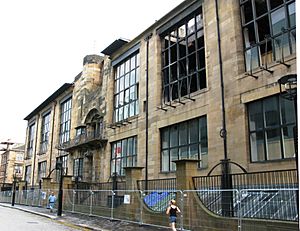
Scotland has had art schools since the 1700s. The Edinburgh College of Art started from the Trustees Academy in 1760 and became its current form in 1907. In 2011, it became part of the University of Edinburgh. The Glasgow School of Art grew from the city's School of Design, founded in 1845. Grays School of Art in Aberdeen was founded in 1885. Duncan of Jordanstone College of Art and Design was founded in Dundee in 1909. There are also smaller private schools like the Leith School of Art, started in 1988. Many major art colleges and universities also offer photography courses.
Organisations
Creative Scotland is the main national organisation that helps develop the arts in Scotland. It took over from the Scottish Arts Council, which had been around since 1967. Local councils and private groups also support the arts. Independent art foundations that promote visual arts include the Royal Scottish Academy, founded in 1826. The Scottish Society for the History of Photography promotes photography.
See Also
- List of Scottish artists
- Scottish art
|


